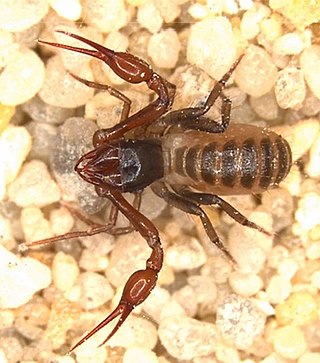
Mole Creek Karst is a national park situated in the North of Tasmania, Australia, 168 km northwest of Hobart. It is located on the slopes of the Great Western Tiers to the east of the town of Mole Creek. It is the only national park in Tasmania created specifically to protect karst landforms. It is part of the Tasmanian Wilderness World Heritage Site.

Pseudotyrannochthoniidae is a family of pseudoscorpions, belonging to the superfamily Chthonioidea. It represents the most basal and primitive group of living pseudoscorpions, with less than 100 species in 6 genera. Living members of the group have a strongly disjunct distribution, likely reflecting ancient vicariance, occurring in Australia, Asia, Southern Africa and Madagascar, Western North America and southern South America. Fossils species are known from the Eocene Baltic and Bitterfeld amber, which represent members of extant Asian genera.
Austrochthonius cavicola is a species of pseudoscorpion in the Chthoniidae family. It is endemic to Australia. It was described in 1968 by Austrian arachnologist Max Beier.
Tyrannochthonius cavernicola is a species of pseudoscorpion in the Chthoniidae family. It is endemic to Australia. It was described in 1976 by Austrian arachnologist Max Beier.
Pseudotyrannochthonius jonesi is a species of pseudoscorpion in the Pseudotyrannochthoniidae family. It is endemic to Australia. It was described in 1962 by American arachnologist Joseph Conrad Chamberlin.
Pseudotyrannochthonius tasmanicus is a species of pseudoscorpion in the Pseudotyrannochthoniidae family. It is endemic to Australia. It was described in 1970 by Australian zoologist Alan Dartnall.
Pseudotyrannochthonius typhlus is a species of pseudoscorpion in the Pseudotyrannochthoniidae family. It is endemic to Australia. It was described in 1970 by Australian zoologist Alan Dartnall.
Pseudotyrannochthonius australiensis is a species of pseudoscorpion in the Pseudotyrannochthoniidae family. It is endemic to Australia. It was described in 1966 by Austrian arachnologist Max Beier.
Pseudotyrannochthonius bornemisszai is a species of pseudoscorpion in the Pseudotyrannochthoniidae family. It is endemic to Australia. It was described in 1966 by Austrian arachnologist Max Beier.
Pseudotyrannochthonius gigas is a species of pseudoscorpion in the Pseudotyrannochthoniidae family. It is endemic to Australia. It was described in 1969 by Austrian arachnologist Max Beier.
Pseudotyrannochthonius queenslandicus is a species of pseudoscorpion in the Pseudotyrannochthoniidae family. It is endemic to Australia. It was described in 1969 by Austrian arachnologist Max Beier.

Pseudotyrannochthonius giganteus is a species of pseudoscorpion in the Pseudotyrannochthoniidae family. It is endemic to Australia. It was described in 1971 by Austrian arachnologist Max Beier.
Pseudotyrannochthonius eberhardi is a species of pseudoscorpion in the Pseudotyrannochthoniidae family. It is endemic to Australia. It was described in 1971 by arachnologists Danilo Harms and Mark Harvey. The specific epithet eberhardi honours Stefan Eberhard, who collected the holotype, for contributions to Australian karst research.
Anatemnus cavernicola is a species of pseudoscorpion in the Atemnidae family. It is endemic to Australia. It was described in 1976 by Austrian arachnologist Max Beier. The specific epithet cavernicola ('cave-dwelling') refers to the species’ habitat.
Austrochernes guanophilus is a species of pseudoscorpion in the Chernetidae family. It is endemic to Australia. It was described in 1967 by Austrian arachnologist Max Beier.
Austrochernes imitans is a species of pseudoscorpion in the Chernetidae family. It is endemic to Australia. It was described in 1969 by Austrian arachnologist Max Beier.
Protochelifer cavernarum is a species of pseudoscorpion in the Cheliferidae family. It is endemic to Australia. It was described in 1967 by Austrian arachnologist Max Beier.
Protochelifer naracoortensis is a species of pseudoscorpion in the Cheliferidae family. It is endemic to Australia. It was described in 1968 by Austrian arachnologist Max Beier. The specific epithet naracoortensis refers to the type locality.
Cryptocheiridium australicum is a species of pseudoscorpion in the Cheiridiidae family. It was described in 1969 by Austrian arachnologist Max Beier.

